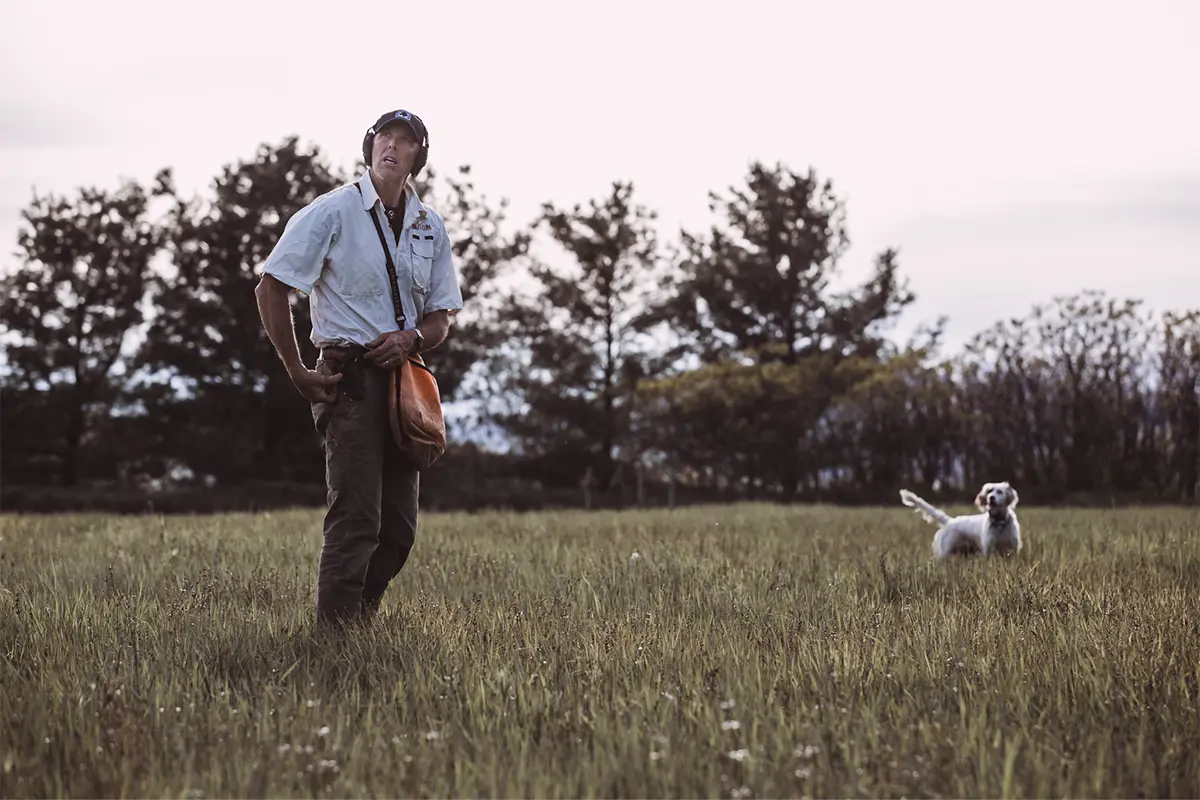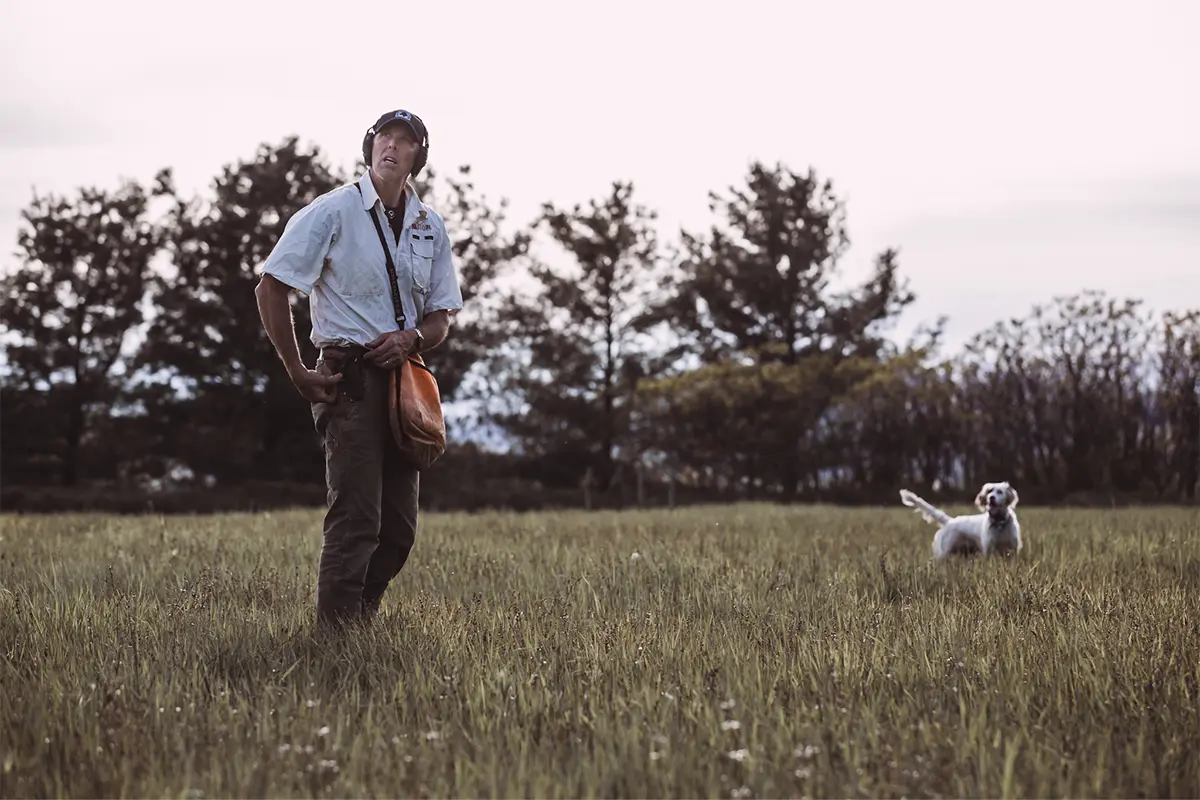

All hunting dogs, including pointers, flushers, and retrievers will likely have to learn how to handle under control and show compliance. (Photo By: Chris Ingram)
Gun dogs are often lumped into three different categories: pointing dogs, flushing dogs, and retrievers. When it comes to choosing your first gun dog (or your next), questions always start swirling. Which one is easiest to train? Which one is hardest? What gear might you need for one versus the others? And what about knowledge required for the various groups?
Advertisement
To help answer some of these questions, I contacted my good friend and longtime dog trainer, Trena Cardwell of Chukarhill Kennels in Kittitas, Washington.

Trena has been a professional dog trainer for more than 35 years, training the whole gamut of sporting dogs, from retrievers and flushers to pointing dogs of nearly every breed. Over that time, the dogs she has trained have won more than two dozen English, Irish, and Gordon setter national field trial championships.
Armed with my set of questions and seeking all the right answers, I was immediately shut down by Trena, who concluded that we had prematurely lumped dogs into three broad categories without properly considering a much more important factor: the individual nature of gun dogs, regardless of breed or purpose.
The Individual Factor
According to Cardwell, it’s not possible to have a valid discussion of pointers, flushers, and retrievers by lumping the dogs into three manmade categories and saying, “Train one this way, train another that way.”
“Every dog is different, it doesn’t matter the breed or what you’re going to do with it,” Cardwell said. “I’m talking about individual dogs. Individuals are just individuals, and they’re all different. They all learn at a different rate. They all learn in different ways regardless of what category you put them in.”
Advertisement
“Which ones are hardest to train? Which are the easiest? Which require more finesse? Which ones require more muscle?” I questioned.
“I still think that’s an individual thing,” Cardwell said. “Some dogs of all types are softer and some are tougher. A field trial Lab is a hard son-of-a-gun generally speaking. They have to be because they take heat like nothing else.”
Setting aside the individual nature of dogs and how hard or easy they are to train, I led Cardwell into a discussion on equipment needed for training the various types—pointers, flushers, and retrievers.
Dog Training Equipment & Resources
Again, however, Cardwell believes there are far more similarities to the equipment needed to train these three distinct types of gun dogs than there are differences.
“A set of good electronic bird launchers is a good thing to have with pointers, flushers, and retrievers,” she said. “A set of good e-collars, too. You’ll also need a check cord and bumpers. Even for pointing dogs, if you’re going to train your pointing dog to retrieve, you’ll need bumpers. And you’ll need a force retrieve table for all three if you’re going to be teaching them to retrieve.”

Above all, Cardwell mentioned that one of the most important tools you’ll need for training all gun dogs, is live birds. She prefers pigeons for most of her training because of their availability and because she can use them again and again. “Regardless of purpose, you can’t make a bird dog without birds,” she said. “It doesn’t matter what kind of bird dog it is, you’ve got to have birds. Pigeons are good for all three types.”
Cardwell believes that property to train on is important for all three styles of hunting dogs. Those training pointing dogs will likely need bigger pieces of property than is necessary for flushers and retrievers since they, by nature, tend to get farther away from their handler.
“Water is crucial, too, if you’re going to make a duck dog or a goose dog,” she added. “And a springer can sit in the duck blind just as well as a Labrador. I’ve had a couple of springers in my career that were very nice duck dogs, but water is not so critical if the dog you’re training isn’t going to be making water retrieves.”
Dog Training Methods
While someone starting out in gun dogs might think training the various types would be vastly different, the similarities again outweigh the differences, according to Cardwell. “There are fundamental basics,” she said. “You get them started the same, then you’re branching off from there.”
To Cardwell, gaining control of the dog from the start is so critical that it outweighs all the other aspects of training, regardless of type of dog and long-range training goals. “The most essential part of training any of those three, is obedience,” she said. “They must come when they’re called. Even a big-running pointing dog must handle. A good springer or a good Labrador must handle. The type of handle will be different, of course, but the non-negotiable part is not.”

Of course, this is where the natural instinct of the various types of gun dogs comes into play, since just as individuals are different, so are dogs bred for different types of hunting. “There’s a big difference in what turns their crank,” Cardwell said. “A Lab puppy will be packing stuff around in its mouth from the time it’s a little guy, and usually so will a springer. Our pointing dogs will run around pointing tweety birds, shadows, flies, and bugs. And they tend to think more independently.”
While similar, there are, of course, some differences in what a gun dog owner should teach various types of puppies from the start. “I wouldn’t teach a pointing dog puppy to sit on command, just because of my field trial and competition background,” Cardwell said. “But I would teach a retriever and flusher to sit, and I would do it with a single blast on the whistle from the time I started teaching them. And I’d teach them to back—which is a straight line away from your body. And I’d teach them to mark. You should also teach all three types to be forward. You don’t want to walk along looking behind you all the time. It just depends on what degree of forward it is. That’s different for the different dogs.”
In the end, however, the training styles needed for the three different types of dogs, once again goes back to considering each individual dog rather than simply saying train a retriever this way, train a pointer this way and train a flusher in this manner. “You can’t just lump them in three different pots,” Cardwell concluded. “Train dogs as individuals, regardless of what you’re training them for, and you’ll have much more success in the long run.”
Advertisement